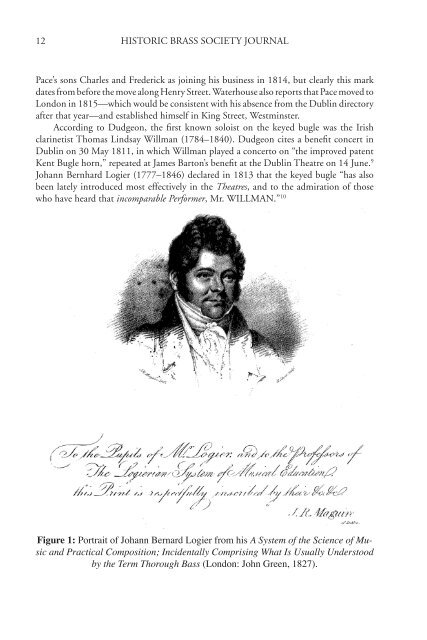New Light on the Early History of the Keyed Bugle Part I: The Astor ...
New Light on the Early History of the Keyed Bugle Part I: The Astor ...
New Light on the Early History of the Keyed Bugle Part I: The Astor ...
You also want an ePaper? Increase the reach of your titles
YUMPU automatically turns print PDFs into web optimized ePapers that Google loves.
12<br />
HISTORIC BRASS SOCIETY JOURNAL<br />
Pace’s s<strong>on</strong>s Charles and Frederick as joining his business in 1814, but clearly this mark<br />
dates from before <strong>the</strong> move al<strong>on</strong>g Henry Street. Waterhouse also reports that Pace moved to<br />
L<strong>on</strong>d<strong>on</strong> in 1815—which would be c<strong>on</strong>sistent with his absence from <strong>the</strong> Dublin directory<br />
after that year—and established himself in King Street, Westminster.<br />
According to Dudge<strong>on</strong>, <strong>the</strong> first known soloist <strong>on</strong> <strong>the</strong> keyed bugle was <strong>the</strong> Irish<br />
clarinetist Thomas Lindsay Willman (1784–1840). Dudge<strong>on</strong> cites a benefit c<strong>on</strong>cert in<br />
Dublin <strong>on</strong> 30 May 1811, in which Willman played a c<strong>on</strong>certo <strong>on</strong> “<strong>the</strong> improved patent<br />
Kent <strong>Bugle</strong> horn,” repeated at James Bart<strong>on</strong>’s benefit at <strong>the</strong> Dublin <strong>The</strong>atre <strong>on</strong> 14 June. 9<br />
Johann Bernhard Logier (1777–1846) declared in 1813 that <strong>the</strong> keyed bugle “has also<br />
been lately introduced most effectively in <strong>the</strong> <strong>The</strong>atres, and to <strong>the</strong> admirati<strong>on</strong> <strong>of</strong> those<br />
who have heard that incomparable Performer, Mr. WILLMAN.” 10<br />
Figure 1: Portrait <strong>of</strong> Johann Bernard Logier from his A System <strong>of</strong> <strong>the</strong> Science <strong>of</strong> Music<br />
and Practical Compositi<strong>on</strong>; Incidentally Comprising What Is Usually Understood<br />
by <strong>the</strong> Term Thorough Bass (L<strong>on</strong>d<strong>on</strong>: John Green, 1827).

















